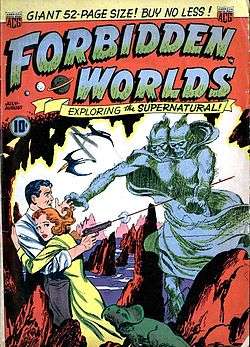Fantasy comics
Fantasy comics have been around as long as the medium itself. The classification "fantasy comics" broadly encompasses illustrated books set in an other-worldly universe or involving elements or actors completely outside the realm of our reality. Fantasy has been a mainstay of fiction or centuries, but the resurgence of fantasy in fiction around the late 1930s and early 1940s, spurred by authors such as C.S. Lewis and J.R.R. Tolkien likely inspired comic book producers who were experiencing an explosion of interest at the time.[1][2] Fantasy-themed books—driven by superhero comics gaining popularity through the 60s—grew to dominate the field. In the 90s, fantasy authors such as Neil Gaiman helped expand the fantasy comics genre to even greater heights with the critically acclaimed Sandman series.
| Fantasy comics | |
|---|---|
 Forbidden Worlds a common example of 1950s fantasy anthologies | |
| Authors |
|
| Publications |
|
| Subgenres | |
| |
| Related genres | |
| Fantasy |
|---|
 |
| Media |
|
| Genre studies |
| Subgenres |
|
| Fandom |
| Categories |
|
|
History
In the US market, early years of fantasy comics began in the Golden Age of Comic Books and were populated with such notable works range from All-American comics' (and later DC comics') Greek myth inspired super hero Wonder Woman to Dell's Tarzan.
Starting in the late 1940s through the mid-1950s horror-themed fantasy anthologies gained prominence; the most famous of these include EC Comics' Tales from the Crypt, Haunt of Fear, and Vault of Horror; and lesser notable titles such as American Comics Group Adventures into the Unknown and Forbidden Worlds though this trend saw its prevalence cease with the publication of Dr. Fredric Wertham's book Seduction of the Innocent which directly led to a Senate hearing of the influence of comics on juvenile violence. Though fantasy comics were able to survive in this new atmosphere though in a diminished capacity compared to its much stronger output in these early years.
Fantasy-themed super heroes continued to populate comics through the 1950s and regained popularity in the 1960s with such characters as Steve Ditko's Doctor Strange published by Marvel comics and Jack Kirby's Thor both appearing in two of Marvel's fantasy-themed anthologies – Strange Tales and Journey into Mystery.
In the 1970s, Conan the Barbarian, created by Robert E. Howard, became one of the most popular publications of Marvel Comics. After some changes of publishers, it continued to be published in the 2010s.
In the 1990s, The Sandman, created by Neil Gaiman, Sam Kieth and Mike Dringenberg took comics on a more literary path.
Notable creators
Adaptations
Several fantasy manga have been or will be adapted into anime television series, including Hakkenden: Eight Dogs of the East (2013),[3] Akame ga Kill! (2014),[4] The Seven Deadly Sins (2014),[5] Trinity Seven (2014)[6] and Akatsuki no Yona (TBA).[7]
See also
References
- Shear, Jeff (2018-03-27). "A Brief History of the Fantasy Genre". Jane Friedman. Retrieved 2019-07-02.
- "Genre Basics: Comic Books and Graphic Novels - article". Author Learning Center. Retrieved 2019-07-02.
- "Hakkenden: Tōhō Hakken Ibun Fantasy Manga Gets Anime". Anime News Network. 27 October 2011. Retrieved 30 July 2014.
- "Akame ga KILL! Dark Action Fantasy Manga Gets TV Anime". Anime News Network. 20 January 2014. Retrieved 30 July 2014.
- "The Seven Deadly Sins Fantasy Manga Gets TV Anime". Anime News Network. 11 April 2014. Retrieved 30 July 2014.
- "School Fantasy Manga Trinity Seven Has Anime in the Works". Anime News Network. 13 February 2014. Retrieved 30 July 2014.
- "Akatsuki no Yona Shōjo Fantasy Manga Gets TV Anime". Anime News Network. 1 July 2014. Retrieved 30 July 2014.